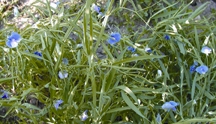Grass Pea

Grass Pea (khesari) a member of the pulse family Leguminosae. Khesari or Grass pea (Lathyrus sativus) is a native of southern Europe and western Asia. In Bangladesh it is grown as a cold-weather crop. It is very hardy and can germinate and grow on land too dry for other crops. It can tolerate water-logging and a wide range of soil conditions, including poor soil. It occupies the first position in terms of area and production among pulses in Bangladesh. Seed yield is about 730 kg/ha.
Khesari is cultivated in about 6,02,000 acres of land, and the total annual production is about 1,77,000 m tons. Khesari is a herbaceous annual with slender, glabrous, freely-branched, winged procumbent stem, and its tap root is well-developed. Leaves are alternate and pinnate, and terminate in 3-5 tendrils. Flowers are solitary in the leaf axils. Pods are oblong and flattened. Seeds are wedge-shaped, angled, brown or grey. Germination is hypogeal. The seeds contain about 10.0% water, 28.2% protein, 0.6% fat, 58.2% carbohydrate, and 3.0% minerals.
It is mostly grown for fodder, but seeds are also eaten as pulse soup. Seeds eaten over a long period can cause lathyrism. The disease is characterized by muscular rigidity, weakness, and paralysis of the leg muscles. The onset of the disease is often sudden. A neurotoxic compound, bita-N-oxalyl aminoalanine (BOAA), present in this species, has been associated with the disease. The crop is cultivated widely in most parts of Bangladesh because it requires low inputs. It has much wider adaptability than any other pulse crop. [Nishit Kumar Paul]
See also pulse.
